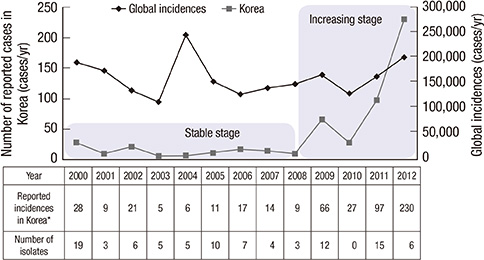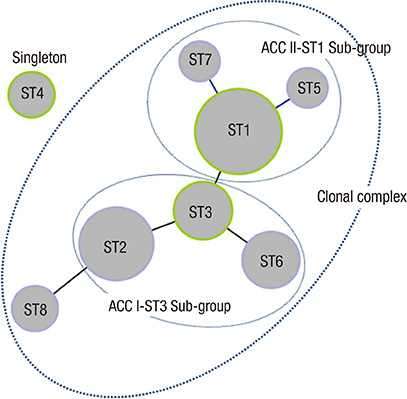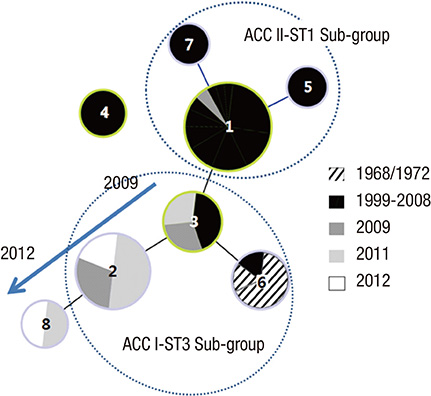J Korean Med Sci.
2014 Mar;29(3):328-333. 10.3346/jkms.2014.29.3.328.
Recent Trends of Antigenic Variation in Bordetella pertussis Isolates in Korea
- Affiliations
-
- 1Division of Bacterial Respiratory Infections, Korea National Institute of Health, Osong, Korea. jungsangoun@gmail.com
- 2Pathogen Resource TF, Korea National Institute of Health, Osong, Korea.
- 3Division of Antimicrobial Resistance, Korea National Institute of Health, Osong, Korea.
- KMID: 1734917
- DOI: http://doi.org/10.3346/jkms.2014.29.3.328
Abstract
- Pertussis is a representative vaccine-preventable disease. However, there have been recent outbreaks in countries where even higher vaccination against the disease. One reason is the emergence of antigenic variants, which are different to vaccine type. In Korea, reported cases have rapidly increased since 2009. Therefore, we analyzed genotype of strains isolated in 2011-2012 by multilocus sequence typing method. As expected, the genotype profiles of tested genes dramatically changed. The major sequence type changed from ST1 to ST2, and new sequence type (ST8) appeared. In the minimum spanning tree, recent isolates belonging to the ACC-I-ST3 subgroup were detected that were composed of ST2, ST3, and ST6. In particular, the ST2 frequency increased to 81%. The novel ST8 was linked to the increased frequency of ST2. In addition, toxic strains carrying the ptxP3 promoter type were confirmed. This ptxP3 type emerged from 2009 and its frequency had increased to 100% in 2012. Based on these results, it can be inferred that the genotypic changes in the currently circulating strains are strongly associated with the recent increasing of pertussis in Korea. Therefore, the surveillance system should be strengthened, and genetic characterization of the isolates should be expanded to the whole genome sequence level.
Keyword
MeSH Terms
-
*Antigenic Variation
Antigens/*genetics/immunology/metabolism
Bacterial Proteins/genetics/metabolism
Bordetella pertussis/*genetics/isolation & purification/*metabolism
Genes, Bacterial
Genotype
Humans
Pertussis Toxin/genetics/metabolism
Promoter Regions, Genetic
Republic of Korea
Sequence Analysis, DNA
Whooping Cough/immunology/*microbiology/pathology
Antigens
Bacterial Proteins
Pertussis Toxin
Figure
Reference
-
1. Mattoo S, Cherry JD. Molecular pathogenesis, epidemiology, and clinical manifestations of respiratory infections due to Bordetella pertussis and other Bordetella subspecies. Clin Microbiol Rev. 2005; 18:326–382.2. De Melker HE, Schellekens JF, Neppelenbroek SE, Mooi FR, Rümke HC, Conyn-van Spaendonck MA. Reemergence of pertussis in the highly vaccinated population of the Netherlands: observations on surveillance data. Emerg Infect Dis. 2000; 6:348–357.3. World Health Organization. Pertussis vaccines: WHO position paper. Wkly Epidemiol Rec. 2005; 80:31–39.4. Rothstein E, Edwards K. Health burden of pertussis in adolescents and adults. Pediatr Infect Dis J. 2005; 24:S44–S47.5. Hochwald O, Bamberger E, Srugo I. The return of pertussis: who is responsible? what can be done? Isr Med Assoc J. 2006; 8:301–307.6. Mooi FR, van Loo IH, King AJ. Adaptation of Bordetella pertussis to vaccination: a cause for its reemergence? Emerg Infect Dis. 2001; 7:526–528.7. Hallander HO, Advani A, Donnelly D, Gustafsson L, Carlsson RM. Shifts of Bordetella pertussis variants in Sweden from 1970 to 2003, during three periods marked by different vaccination programs. J Clin Microbiol. 2005; 43:2856–2865.8. Elomaa A, Advani A, Donnelly D, Antila M, Mertsola J, Hallander H, He Q. Strain variation among Bordetella pertussis isolates in finland, where the whole-cell pertussis vaccine has been used for 50 years. J Clin Microbiol. 2005; 43:3681–3687.9. Centers for Disease Control and Prevention (CDC). FDA approval of expanded age indication for a tetanus toxoid, reduced diphtheria toxoid and acellular pertussis vaccine. MMWR Morb Mortal Wkly Rep. 2009; 58:374–375.10. Centers for Disease Control and Prevention (CDC). FDA approval of expanded age indication for a tetanus toxoid, reduced diphtheria toxoid and acellular pertussis vaccine. MMWR Morb Mortal Wkly Rep. 2011; 60:1279–1280.11. Van Loo IH, Heuvelman KJ, King AJ, Mooi FR. Multilocus sequence typing of Bordetella pertussis based on surface protein genes. J Clin Microbiol. 2002; 40:1994–2001.12. Packard ER, Parton R, Coote JG, Fry NK. Sequence variation and conservation in virulence-related genes of Bordetella pertussis isolates from the UK. J Med Microbiol. 2004; 53:355–365.13. Mooi FR, van Loo IH, van Gent M, He Q, Bart MJ, Heuvelman KJ, de Greeff SC, Diavatopoulos D, Teunis P, Nagelkerke N, et al. Bordetella pertussis strains with increased toxin production associated with pertussis resurgence. Emerg Infect Dis. 2009; 15:1206–1213.14. Jung SO, Moon YM, Kim SH, Sung HY, Kwon SJ, Kang YH, Yu JY. Multilocus sequence analysis of housekeeping genes and antigenic determinant genes in Bordetella pertussis strains isolated in Korea. Osong Public Health Res Perspect. 2011; 2:115–126.15. Kumar S, Tamura K, Nei M. MEGA3: integrated software for molecular evolutionary genetics analysis and sequence alignment. Brief Bioinform. 2004; 5:150–163.16. Jolley KA, Feil EJ, Chan MS, Maiden MC. Sequence type analysis and recombinational tests (START). Bioinformatics. 2001; 17:1230–1231.17. Francisco AP, Vaz C, Monteiro PT, Melo-Cristino J, Ramirez M, Carriço JA. PHYLOViZ: phylogenetic inference and data visualization for sequence based typing methods. BMC Bioinformatics. 2012; 13:87.18. Diavatopoulos DA, Cummings CA, Schouls LM, Brinig MM, Relman DA, Mooi FR. Bordetella pertussis, the causative agent of whooping cough, evolved from a distinct, human-associated lineage of B. bronchiseptica. PLoS Pathog. 2005; 1:e45.19. Mooi FR. Bordetella pertussis and vaccination: the persistence of a genetically monomorphic pathogen. Infect Genet Evol. 2010; 10:36–49.20. Mooi FR, van Oirschot H, Heuvelman K, van der Heide HG, Gaastra W, Willems RJ. Polymorphism in the Bordetella pertussis virulence factors P69/pertactin and pertussis toxin in the Netherlands: temporal trends and evidence for vaccine-driven evolution. Infect Immun. 1998; 66:670–675.21. King AJ, van Gorkom T, van der Heide HG, Advani A, van der Lee S. Changes in the genomic content of circulating Bordetella pertussis strains isolated from the Netherlands, Sweden, Japan and Australia: adaptive evolution or drift? BMC Genomics. 2010; 11:64.22. King AJ, van der Lee S, Mohangoo A, van Gent M, van der Ark A, van de Waterbeemd B. Genome-wide gene expression analysis of Bordetella pertussis isolates associated with a resurgence in pertussis: elucidation of factors involved in the increased fitness of epidemic strains. PLos One. 2013; 8:e66150.23. Spratt BG. Multilocus sequence typing: molecular typing of bacterial pathogens in an era of rapid DNA sequencing and the internet. Curr Opin Microbiol. 1999; 2:312–316.24. Schmidtke AJ, Boney KO, Martin SW, Skoff TH, Tondella ML, Tatti KM. Population diversity among Bordetella pertussis isolates, United States, 1935-2009. Emerg Infect Dis. 2012; 18:1248–1255.25. Advani A, van der Heide HG, Hallander HO, Mooi FR. Analysis of Swedish Bordetella pertussis isolates with three typing methods: characterization of an epidemic lineage. J Microbiol Methods. 2009; 78:297–301.
- Full Text Links
- Actions
-
Cited
- CITED
-
- Close
- Share
- Similar articles
-
- Multilocus Sequence Analysis of Housekeeping Genes and Antigenic Determinant Genes in
Bordetella pertussis Strains Isolated in Korea - Update on pertussis and pertussis immunization
- Discriminative PCR of Bordetella pertussis from closely related Bordetella species using 16S rDNA Gene
- Pertussis Accompanying Recent Mycoplasma Infection in a 10-Year-Old Girl
- Investigation on the Immunity to Pertussis in the Korea
- Multilocus Sequence Analysis of Housekeeping Genes and Antigenic Determinant Genes in






